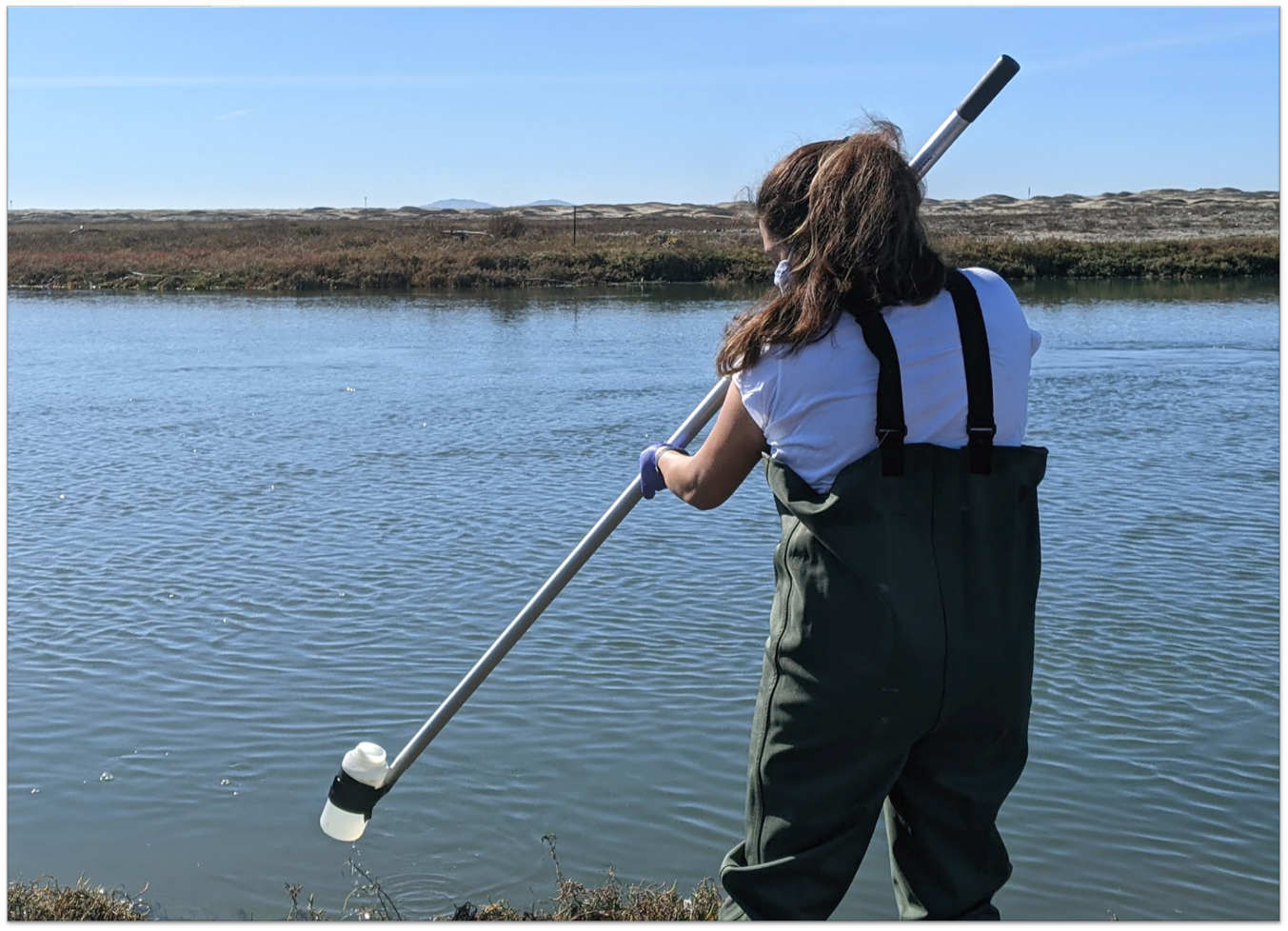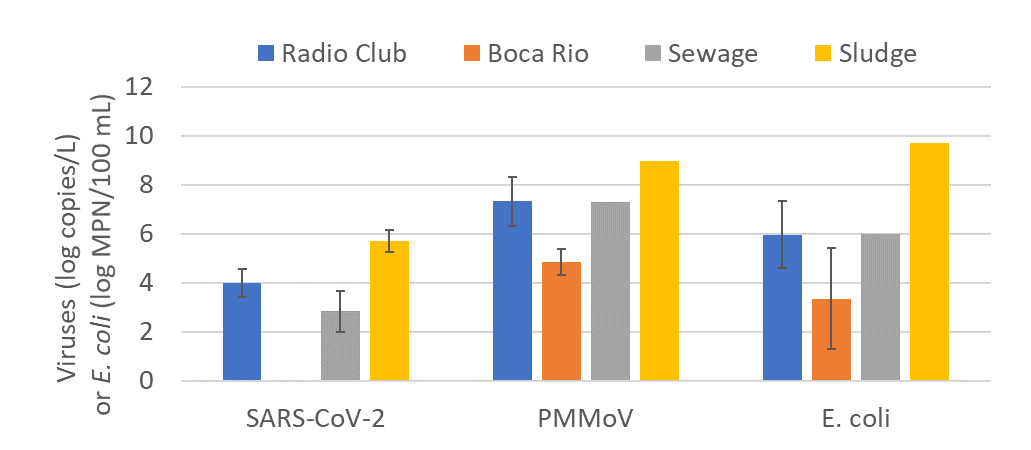Alma Rocha, Dr. Natalie Mladenov, Dr. Matthew Verbyla and Dr. Kari Sant, San Diego State University
October 29, 2021
The COVID-19 pandemic has led to the discovery that genetic material from the novel coronavirus SARS-CoV-2 is excreted in the feces of infected individuals and can be detected in sewage. This has sparked questions regarding the persistence of the virus and its genetic signal in polluted waters. Cities, schools, and other communities now have ongoing monitoring programs to track concentrations of SARS-CoV-2 in raw sewage to gain insight and early warnings for COVID-19 outbreaks and introduction of genetic variants. The work described below has advanced our understanding of the persistence of SARS-CoV-2 in wastewater-dominated waterways and the optimal methods for detecting and quantifying SARS-CoV-2 in both natural waters and wastewater matrices.
In Tijuana, Mexico, and many other rapidly urbanizing cities around the world that lack adequate sewage conveyance infrastructure, streams, rivers, and other open channels serve to convey raw sewage and other pollutants and debris downstream to coastal areas (Figure 1). Even in cities with comprehensive centralized sewage conveyance, raw sewage may be introduced into riverine and coastal environments via leaky sewer lines, sewer overflows, illegal discharges, and ocean sewage outfalls (which may contain both treated and untreated wastewater). In these cases, tracking SARS-CoV-2 in surface waters can provide information on the prevalence of the virus in communities without sanitation or sewer connections, as well as communities with open conveyance of wastewater.
Figure 1. Debris in the Tijuana River near the Dairy Mart bridge at low flow. Photo credit: N. Mladenov.
The Tijuana River is an international river, shared by the United States and Mexico, that flows into the Pacific Ocean near the City of Imperial Beach, California. For decades, severe pollution of the Tijuana River and its frequent transport of raw sewage to the Pacific Ocean, which impacts surrounding coastal areas, has been a contentious and complex transboundary water issue. The goals of this study were to determine if SARS-CoV-2 could be detected in this waterway and, if so, track concentrations of SARS-CoV-2 in the Tijuana River during 2020 and 2021 and compare those results to community infection rates in the city of Tijuana.
 Figure 2. Graduate student Alma Rocha collecting samples at the mouth of the Tijuana River. Photo credit: K. Sant
Figure 2. Graduate student Alma Rocha collecting samples at the mouth of the Tijuana River. Photo credit: K. SantOur team, led by graduate student Alma Rocha, collected grab samples from two sites on the Tijuana River: Boca Rio at the mouth of the Tijuana River and Radio Club further upstream near the border (Figure 2 and Figure 3). Samples were collected 1) after storm events, 2) during dry weather conditions, 3) when COVID-19 infection rates were high in Tijuana, and 4) following an increase in vaccination rates and a decrease in COVID-19 cases in Tijuana. For comparison, samples of raw sewage and biosolids (the sludge that settles out in basins during wastewater treatment) were also collected from the Point Loma Wastewater Treatment Plant and the San Elijo Water Reclamation Facility in San Diego County. Samples were analyzed for chemical water quality and microbial constituents, including total coliforms, Escherichia coli, enterococci, and pepper mild mottle virus (PMMoV), a human-associated viral indicator derived from pepper plants and found in human fecal material.
An important initial step in the project was the development of methods for detecting and measuring SARS-CoV-2 in wastewater and natural waters. We had to address filter clogging issues, optimize the sample preparation workflow, and decrease the long sample preparation time. We did a significant amount of laboratory experimentation to develop refined methods that allowed us to detect and measure the concentration of SARS-CoV-2 in wastewater influent, sludge, and surface waters.
Figure 3. Map showing Boca Rio and Radio Club sampling sites on the Tijuana River north of the
US-Mexico border. Photo credit: K. Sant
Using our newly developed methods, SARS-CoV-2 was detected and measured in raw sewage, sludge, and at the more upstream Radio Club site on the Tijuana River on six out of eight occasions. The SARS-CoV-2 concentrations at the upstream Radio Club site were as high or higher than those detected in untreated wastewater collected in the spring and summer of 2020 (Figure 4). Other indicators of human fecal contamination (PMMoV and
E. coli) at Radio Club were also as high as in raw sewage samples. The virus was not, however, detected at the downstream Boca Rio estuarine sampling location, despite the consistent detection of high concentrations of PMMoV at that location, which indicates human fecal contamination. This lack of SARS-CoV-2 detection at Boca Rio may be due to a combination of factors: 1) its occurrence just below detection limits, 2) removal or degradation of the virus during transport along the Tijuana River, and 3) mixing of river water with uncontaminated ocean water in the coastal zone around the Boca Rio site.

Figure 4. Mean concentrations and standard deviations of SARS-CoV-2, PMMoV, and E. coli in the Tijuana River at the Radio Club site (n = 6) and Boca Rio site (n = 6). Mean and standard deviation of SARS-CoV-2 in 6 sewage samples and 9 sludge samples for San Diego County wastewater treatment plants, and typical PMMoV and E. coli values for sewage and sludge.
Covid-19 infection rates tracked changes in SARS-CoV-2 concentrations at Radio Club: high riverine concentrations occurred just before high infection rates were observed among citizens of Tijuana. Our study did not seek to evaluate the viability or infectivity of the virus in raw sewage or surface water, and there is currently no evidence that the virus maintains viability in sewage or surface waters. However, due to the persistence of the genetic material of SARS-CoV-2 in the Tijuana River, surveillance of the virus in this waterway may be useful for tracking prevalence and future outbreaks.
Alma Rocha is a MS candidate in Civil Construction and Environmental Engineering at San Diego State University. Dr. Natalie Mladenov is an Associate Professor and Dr. Matthew Verbyla is an Assistant Professor of Civil Construction and Environmental Engineering at San Diego State University. Dr. Kari Sant is an Assistant Professor of Environmental Health at San Diego State University. COAST provided funding for this project through a
Rapid Response Funding Program
Award# COAST-RR-2020-01, June 2020.